|
|
|
|||
|
|
||||
|
|
||||
| The (Jet)X Files | ||||
|
|
HOME | SITE MAP | FORUM | CONTACT |
|
||
|
ABOUT | MOTORS | MODELS | ARCHIVE | HISTORY | STORE | FAQ | LINKS
|
|
|
|
|
|
|||||||||||||||||||||||||||||||||||||||||||||||||||||||||||||||||||||
|
The (Jet)X Files 21
(September 2004)
by Roger Simmonds Reprinted from SAM 35 Speaks, September 2004 Reheat It is a pity that Veron’s Jetex designs are still something of a rarity on the flying field. The 1951 fighters have an honourable place in our history, being amongst the first practical kits of free flight jet propelled ‘scale’ models, predated only by Howard Boys’ Powakits products and the Wilmot Mansour Vampire. Phil Smith set a standard and established the paradigm for Albert Hatfull, Bill Dean, Ray Booth and any number of independent designers followed. The Attacker, Sabre, Seahawk and Thunderjet [right] were widely imitated, and the trough, that clever solution to the conundrum, ‘where to put the motor?’ was widely copied, though without attribution. The models strike one as rather large compared to those of later ‘Flying Scale’ series, and they were unashamedly semi-scale (for example the Seahawk lacked nacelles and the Sabre sported reduced sweepback), but they were fine fliers. There was a rather inept review of the ‘Veron Scale-Jet Range’ (as it was called) in the December 1951 Aeromodeller which began: “Selected for test … the Thunderjet … 18 in. wingspan … Our weight, with unloaded Jetex 50, 2 oz. For packaging, quality and completeness we can say that this new range of Jetex powered scale fighters is the best. |

- Aeromodeller Annual, 1951 (p. 106)
|
|||||||||||||||||||||||||||||||||||||||||||||||||||||||||||||||||||||
|
“The Thunderjet was finished and ready to fly eight hours from opening the box, and that includes time for colour doping! The instructions are foolproof … the neat groove for the partially enclosed Jetex unit is easily attained”. So far so good, but the reviewer should perhaps have taken more care over finishing: “The colour dope made the test T’jet heavy and performance with Jetex 50 was correspondingly relatively mediocre. However, we found a good application of this realistic model to catapult launch, and flights up to 150 ft. altitude and lasting up to 30 secs were repeatedly obtained. Flying speed is fast, and catapult launch with 3 yards of ¼" flat rubber puts the T’jet in the air at an extra high scale-speed”. This method of launching (it is not clear whether this was with or without motor assist) is more akin to a bungee launch; I would like to see it tried today. Physics of Flight has offered ‘short kits’ for these Veron designs (based on the original plans) for some time, and if built light they go very well with Rapier L2s. But I can now reveal that Phil Smith has redrawn his plans and Aerographics will be offering complete kits in the near future. This is a mouth-watering prospect and will make the reproduction of these attractive vintage designs a little easier. I hope many people will give them a go. I wonder if George will include an undercarriage and 3 yards of ¼" flat rubber in the box. |
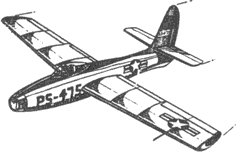
- Phil Smith's catalogue of plans, 2004
|
|||||||||||||||||||||||||||||||||||||||||||||||||||||||||||||||||||||
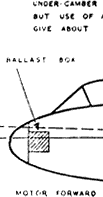
|
|
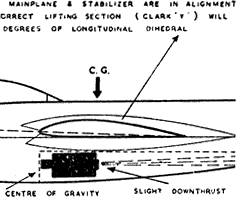 Normal arrangement of Jetex scale model (detail)
-
Aeromodeller Annual, 1951, p. 104
|
||||||||||||||||||||||||||||||||||||||||||||||||||||||||||||||||||||
Brian remembers a CO2 car featured in an early Eagle Annual that was backed sharply onto a fixed spike. The Jet Racer’s method was more sophisticated; “Place the Sparklet in car, put end of Sparklet in hole in base of block, pull back striker arm, let go, Whoosh!” Tony says he had ‘long suffering parents’ (didn’t we all?) and reminisces about RTP in the family sitting room. He concludes his letter: “I think it would be possible to launch the Speedjet off a ramp with a device like this. I was ten years old at the time … but not anymore.” Graham Knight came across another free flight CO2 model, the curiously called ‘Jets Ray
|
|
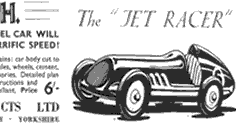

CO2 Jet Racer
- Aeromodeller Dec. 1947
|
||||||||||||||||||||||||||||||||||||||||||||||||||||||||||||||||||||
|
|
|
||||

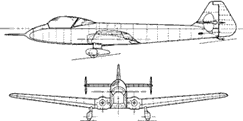 The pretty Miles M.77 Sparrowjet (1953) [above] was a derivative of their pre-war lightweight M.5 Sparrowhawk racer [below].  Powered by twin Turbomeca Paias turbojets of 331 lb. thrust, the Sparrowjet had a top speed of 230 mph (Mach 0.3). I wonder if there is a vintage Sparrowhawk plan that could be converted to a twin L1 Sparrowjet. I don’t think Leigh flew the Zephyr (which is authentically finished in white tissue with red trim) at July’s Old Warden Meeting, as the weather was wet and windy. Pete Williams has some comments about the possible corruption of old plans. I had found to my chagrin, you will remember, that the wings of my Hunter did not match. Pete writes, “Your remarks re the Skyleada Hunter were intriguing. I got out some of my copies, and yes, there are discrepancies. Then I measured up my original. Guess what? Same discrepancies! Nothing to do with ‘generations of copying’. I shall keep on supplying copies as is!” This is most strange, and I wonder how widespread this phenomenon is. Does any reader know of any other inaccurate plans? Should a replica of a period model include these anomalies? |
|
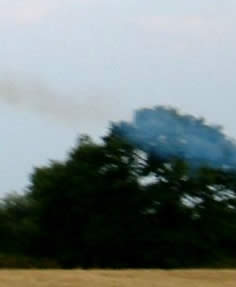
- Leigh Richardson
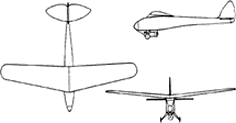 |
|||
|
Finally, in our rechauffé of topics featured in recent (Jet)X Files, Geoff Hindley, Peter Spalding, Stan Pearson and Peter Cameron all sent me details of Henri Coanda’s ‘jet turbine’ sesquiplane. The 3-view of the prototype that was exhibited at the Salon de l’Aéronautique, October 1910, [right] is taken from a Sampson Low guide, Aircraft Origins (1977). The span is given as about 33 ft for a length of 39.5 ft, and the engine as a water-cooled four cylinder in-line 50 hp Clerget. This drove a centrifugal compressor at 4,000 rpm. In front of this was an ‘obturator’ that controlled the air intake to the ‘combustor’; the hot gases were evacuated on both sides of the fuselage. A thrust of 220 Kg was claimed for this ‘air reactive engine’. I was wrong about the design’s suitability for stringer and tissue construction, as the original structure was ‘steel tubing covered in polished mahogany plywood’. Coanda claimed a short flight under jet power and has written: “the airplane moved faster and faster, and flames and fumes could be seen along the fuselage getting out from the engine [sic] … impressed by the flames I lost control”. This tale is not undisputed. Munson (Pioneer Aircraft, 1969) believed the thrust from the fan unit would have been quite inadequate, adding, “the suggestion that it flew as a petrol-burning jet can be dismissed simply by considering the location of the pilot to the jet efflux”. Still it’s a nice story, and whilst this particular claim may be a load of Benson-Balls, Coanda’s achievements in other spheres are incontrovertible. [Ed.: You can read more about Coanda's "Wooden Wonder", including an illustrated account of modelling it, at Cross & Cockade International, the website of the Society of First World War Aero Historians.] Mr. Beer Trophy for Scale Jet Planes, Old Warden, Sunday July 25 |
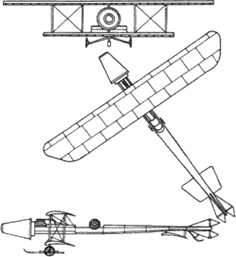
- Aircraft Origins (Sampson Low) 1977
|
||||
|
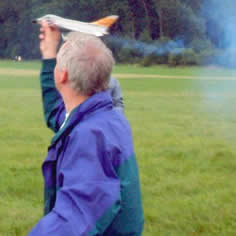 |
||||
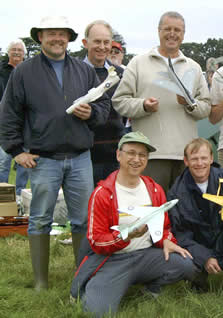
The weather closed in soon afterwards, becoming quite blustery, but this didn’t prevent some interesting and eventful flights by Derek Knight’s EDF Panther, Pete Smart’s twin engined Badger, Andy Blackwell’s TSR 2, or the trimming of my Douglas Skyrocket [below right]. This flew ‘off the board’ as they say, all but emasculating Richard Crossley on its maiden flight. As Richard is the designer of this shapely little model (see photo in last month’s column) this would, I suppose, be a case of being ‘hoist with your own petard’!
All in all, this event was an excellent demonstration of free flight in general and rocket planes in particular. Tony Betts is to be congratulated for instigating this competition; it showed the amount of interest out there, and may lead to another competition with an emphasis on ‘vintage’ Jetex models. We shall see. Genesis of the Model Jet Earlier this year I reproduced a sketch of a model athodyd and test rig remembered by Eric Marsden from an early post-war Aeromodeller. I have now, thanks to Sir Simeon Bull, copies of a series of articles (general title, ‘Jet Propulsion and its application to Model Aircraft’) that were published between 1945 and 1949. These essays are an intriguing reflection of their times and worth reviewing in some depth. |
|
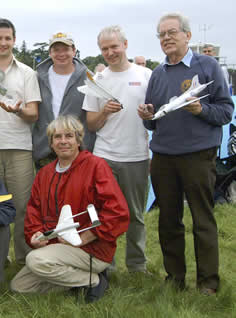 Old Warden, July 25 2004 Front row l.-r.: Roger Simmonds, Andy Blackwell, Chris Metcalf Back row l.-r.: Kevin Wallace, Anthony Druce, Pete Smart, Richard Crosley, Tony Betts, Mike Stuart, Derek Knight
- Roger Simmonds

- Roger Simmonds
|
|||

An introduction to jets appeared in the later that same year by, I think, a C R Tootle (I do not have this reference), and a second article, simply entitled ‘Jet Propulsion’, by G W W Harris, followed in January 1945. Little was known about jet motors at the time (unsurprising given wartime censorship) and Harris’s crude experiments were, as he acknowledges, (with only a little exaggeration) ‘shots in the dark’. Though the next article, ‘Jet Propulsion and its Possible Application to Model Aircraft’, (May 1945), includes a reasonable illustration of an axial jet turbine, Harris is, as the tentativeness of the title suggests, even less sure of his ground. He states with some resignation, “correspondence reveals some confusion exists in the minds of many readers as to what is meant by Jet Propulsion and why does it differ from rocket propulsion” [sic]. R H Eaton-Williams seeks to address this confusion in the same issue of Aeromodeller with his ‘Theory of Model Reaction Propulsion’, an impressive though all but unreadable essay replete with many equations. In the follow-up article (October 1945), Harris, now reassured that his readers may understand what he is talking about, and having dealt with ignition issues, surveys compressors, from ‘pressure blowers’ to ‘squirrel cages’. All good stuff. However, it has to be said that Harris’s ‘jet motors’ were little more than electric ducted fans with afterburners. They were obviously a lot of fun, if not without their hazards (Harris reports he set fire to his neighbour’s (!) garden fence), and useful, perhaps, in the preparation of crème brulée, but of little real application to the propulsion model aircraft. |
|
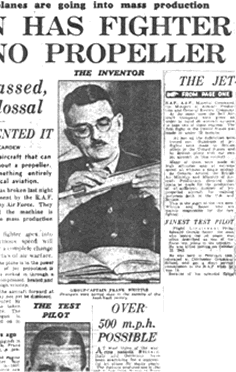
- Daily Express, Jan. 7 1944
|
|||
|
The next article, ‘The development of a model jet unit’ (December 1945) is by a Sgt G A Henwood. Henwood is both more sanguine and optimistic. He writes “The author’s object was the production of a unit that was both simple and easy to construct … I was forced to discard the use of compressors in favour of something much more simple”. His unit, which is actually a ramjet, is the one Eric so ably illustrated. Harris tested one of these in a tethered rig. After some tinkerings and modifications he reports: (January 1946), “The tank was half-filled with methylated spirits and then pumped up … the needle valve was opened until fuel issued forth from the jet ring, and this was ignited. After giving forth a flame the unit burst into a slight roar, and a little manipulation of the valve increased this to a very healthy note, whilst the combustion tube quickly turned a bright red. Without hesitation it began to move forward – at first slowly – then with increasing speed until it became just a glowing streak … on the sixth revolution it detached itself in no uncertain manner”. Harris was obviously impressed, and though he admitted that he hadn’t measured the unit’s output, he concludes, with unwarranted optimism, if not downright insouciance, “it now remains to complete a unit that is just a bit lighter and gives a bit more thrust, fit it to a flying wing, and fly it”. Oh dear! Harris’s next article (May 1946) begins with some excitement, “It’s happened at last, the first jet-propelled model has taken to the air, if not completely satisfactorily”. Somewhat disappointingly, this was not a Harris Flying wing with a Henwood ramjet, but a modified ‘Aeolus’ glider fitted with a unit “of the impulse duct type of athodyd with six flap valves”, (i.e a pulsejet) built by a “F/Lt. Long of the Doncaster MAC” [right]. Harris quotes F/Lt Long: “I do not consider the flight made by my model to be of any use as the model merely waffled [sic] round in a semi stalled condition … better results might have been gained with a model designed for the motor, but with so little power available, such a model would have been of flimsy construction”. Harris reports that Long was now working on “a turbo-jet intended to drive an airscrew, and readers will wish him an equal or greater success in the new venture”. This is, however, the last we hear from Harris, Henwood, or for that matter, F/Lt Long and his turbo prop. There is now a gap of two years until November 1948, when the first of three articles under the general title, ‘Gas Turbine Experiments’, by L G Cramp, appears. Cramp begins: “One seems to hear little or nothing on the subject of model jet propulsion, and the writer, having carried out some research in this field over the last four years, would like to contribute a little toward reviving some interest among modellers”. This assertion is more than a little odd, given the publication of Bowden’s book Model Jet Reaction Engines and the launch of Jetex earlier that year! Cramp continues, “the idea of a little power unit buried snugly in the fuselage of a nicely streamlined model has often appealed to many as the ultimate in the design of model aircraft … but it must be borne in mind that the disadvantages are by no means small”. |

- Aeromodeller , January 1946

- Aeromodeller , May 1946
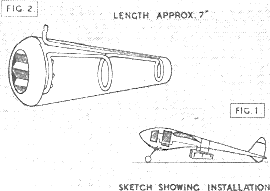
- Aeromodeller , May 1946
|
||||
|
Cramp’s experimental program appears to be an analogue (it would be unkind to call it a parody) of Whittle’s full-size programme of twenty years earlier. The first experiments are a return to Harris’s initial exploration, albeit with more sophistication and the generation of meaningful data. Though the test rig illustrated on the right shows an axial compressor, Cramp rightly concludes that a centrifugal compressor is the way to go. The second article (December 1948) is quite a heavy read, and deals with turbine design and gas temperature. Though he overlooks the option of a centrifugal turbine, he is again on the right track, and predicts that 20-30.000 rpm at least would be necessary for a useful thrust. The third and longest article (January 1949) describes in some detail the construction and operation the most sophisticated and modern looking model jet engine we have seen so far so far [below right]. |

- Aeromodeller , Nov. 1948
|
||||
|
It was started by an electric motor. Cramp reports, “At first, there was only a slight increase in pressure in the combustion chamber, while the rpm was in the region of 6,000, so that little work, if any, was being done by the compressor”. Higher revs, though, brought “some success”; “the unit began to accelerate with a high pitch scream, but the temperature was terrific and it would definitely have been unwise to continue”. This turbine, then, may have been briefly self-sustaining, the first time this had been achieved. Cramp concludes (and it is unfortunately the last we hear of him), “This little unit has served its purpose well before giving out, and the writer has only one regret, that he was unable to take a measurement of the thrust … [but] at least he has satisfied himself that it is possible for a small gas turbine to function, though admittedly very inefficiently”. These last articles were really quite prescient, and when the first viable miniature jet turbines appeared in the 1980s (I think we can discount Benson-Ball’s claims), their design, though based on contemporary Diesel turbocharger technology had similarities to Cramp’s final prophetic, but alas firmly bench bound, experiment. |

- Aeromodeller, Jan. 1949
|
||||
The next ‘jet’ article (April 1949), ‘Jets without tears’ by S/Ldr Lord, is sensible, if something of a comedown (the title says it all) and only discusses C/L pulsejets. This is followed in October with ‘Control line Jet Speed Models’ by (who else?) R H Warring. Practicability and sanity thus arrive in the pages of Aeromodeller, unfortunately at the expense of excitement and engineering hubris, and the extraordinary model jet saga, 1945-1949, comes to an end. As I said earlier, the announcement of the Gloster Meteor and the peremptory arrival of the V.1 engendered much interest and excitement in air-minded schoolboys. The cartoon (right) appeared in Aeromodeller, August 1945. |
|
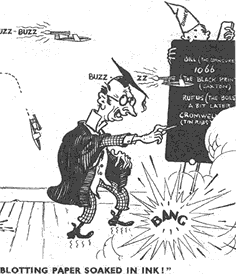
- Aeromodeller, Aug. 1945
|
|||
|
|
|
||||
|
|
|
|
|
|
|
|
Acknowledgements - Article: Roger Simmonds - Illustrations: Roger Simmonds, Phil Smith, Tony Thorn, Graham Knight, Leigh Richardson, MAAC archives via Bill Henderson |
|
|
|
|
ABOUT | MOTORS | MODELS | ARCHIVE | HISTORY | STORE | FAQ | LINKS |
|
|
Terms of Use
|
Queries? Corrections? Additions?
Please
contact us.
|
|